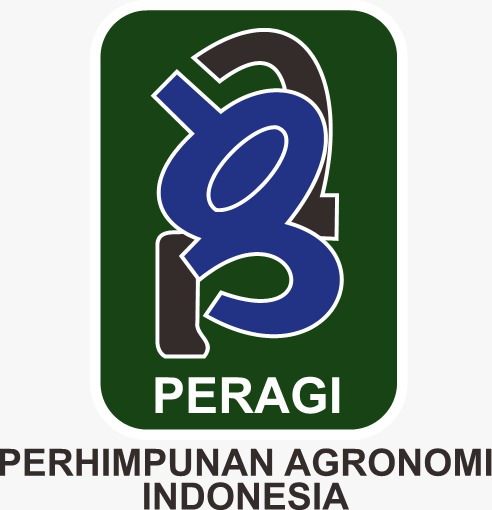Strategy For Controlling Bacterial Leaf Blight (Xanthomonas sp.) on Eucalyptus Pellita Plants by Administering P. aeruginosa RE081
Abstract
The demand for Eucalyptus Pellita seeds as a high-throughput inoculum (HTI) crop commodity in the field is extremely high. However, Xanthomonas sp., a bacteria that causes bacterial leaf blight, poses a significant challenge in ensuring a steady supply of healthy seedlings in nurseries. Researchers have explored using the rhizobacteria P. aeruginosa RE081 as an environmentally friendly biocontrol agent to address this issue. This study aims to determine the optimal concentration of P. aeruginosa RE081 that can effectively reduce the incidence and severity of bacterial leaf blight caused by Xanthomonas sp. The research was conducted using a completely randomized design, with different concentrations of P. aeruginosa RE081 (105, 106, 107, 108 CFU/mL) being tested. The findings indicate that the biological agent's concentration significantly impacts plant disease occurrence and severity. In vivo testing revealed that P. aeruginosa RE081 reduced disease severity by only 2.13% at a 108 CFU/mL concentration. Interestingly, concentrations lower than 108 CFU/mL increased disease severity compared to the control group.
Downloads
References
Bophela, K. N., Venter, S. N., Wingfield, M. J., Duran, A., Tarigan, M., & Coutinho, T. A. (2019). Xanthomonas perforans: a tomato and pepper pathogen associated with bacterial blight and dieback of Eucalyptus Pellita seedlings in Indonesia. Australasian Plant Pathology, 48(6), 543–551. https://doi.org/10.1007/s13313-019-00657-9
Fathi, F., Riseh, R. S., Khodaygan, P., Hosseini, S., & Skorik, Y. A. (2021). Microencapsulation of a pseudomonas strain (Vupf506) in alginate–whey protein–carbon nanotubes and next-generation sequencing identification of this strain. Polymers, 13(23). https://doi.org/10.3390/polym13234269
Fatimah, S., Susanto, M., Lukmandaru, G., Hasil, B. T., Fakultas, H., Universitas, K., Mada, G., Besar, B., Bioteknologi, P., Tanaman, P., & Yogyakarta, H. (2013). Studi Komponen Kimia Kayu Eucalyptus Pellita F. Muell Dari Pohon Plus Hasil Uji Keturunan Generasi Kedua Di Wonogiri, Jawa Tengah.
Ghadamgahi, F., Tarighi, S., Taheri, P., Saripella, G. V., Anzalone, A., Kalyandurg, P. B., Catara, V., Ortiz, R., & Vetukuri, R. R. (2022). Plant Growth-Promoting Activity of Pseudomonas aeruginosa FG106 and Its Ability to Act as a Biocontrol Agent against Potato, Tomato and Taro Pathogens. Biology, 11(1). https://doi.org/10.3390/biology11010140
Hadianto W, Hakim L dan Bakhtiar. (2015). Ketahanan beberapa genotipe padi terhadap penyakit hawar daun bakteri (Xanthomonas oryzae pv. Oryzae) (Vol. 15, Issue 2).
Heo, A. Y., Koo, Y. M., & Choi, H. W. (2022). Biological Control Activity of Plant Growth Promoting Rhizobacteria Burkholderia contaminans AY001 against Tomato Fusarium Wilt and Bacterial Speck Diseases. Biology, 11(4). https://doi.org/10.3390/biology11040619
Kanugala, S., Kumar, C. G., Rachamalla, H. K. R., Palakeeti, B., Kallaganti, V. S. R., Nimmu, N. V., Cheemalamarri, C., Patel, H. K., & Thipparapu, G. (2019). Chumacin-1 and Chumacin-2 from Pseudomonas aeruginosa strain CGK-KS-1 as novel quorum sensing signaling inhibitors for biocontrol of bacterial blight of rice. Microbiological Research, 228. https://doi.org/10.1016/j.micres.2019.126301
Kirtanayasa, IGYA. (2022). Literatur Review : Aktivitas Antibakteri Beberapa Ekstrak Tanaman Terhadap Bakteri Klebsiella Pneumonia I Gede Yoga Ayuning Kirtanayasa. https://doi.org/10.22225/ga.27.2.5389.107-111
Lukkani, N. J., & Surendranatha Reddy, E. C. (2014). Evaluation of plant growth promoting attributes and biocontrol potential of native fluorescent pseudomonas spp. Against aspergillus niger causing collar rot of ground nut. www.ijpaes.com
Marfungah, S., Puspita, F., Tjahjono, B., Siregar, B. A., & Gafur, A. (2023). Potential of Indigenous Rhizobacteria as Biocontrol Agents of Xanthomonas sp.
Moustafa, H., And, H., & Fridovich, I. (1980). Mechanism of the Antibiotic Action of Pyocyanine. In JouRNAL OF BACTERIOLOGY (Vol. 141, Issue 1).
Rahayu, S., & Nurcahyanti, S. D. (2020). Pengendalian Penyakit Pustul Xanthomonas axonopodis pv. glycines Pada Kedelai Dengan Bacillus spp. Asal Filosfer Gulma di Pertanaman Kedelai. Jurnal Pengendalian Hayati, 2(2), 53. https://doi.org/10.19184/jph.v2i2.17141
Reisberg, E. E., Hildebrandt, U., Riederer, M., & Hentschel, U. (2013). Distinct phyllosphere bacterial communities on Arabidopsis wax mutant leaves. PLoS ONE, 8(11). https://doi.org/10.1371/journal.pone.0078613
Rijavec, T., & Lapanje, A. (2016). Hydrogen cyanide in the rhizosphere: Not suppressing plant pathogens, but rather regulating availability of phosphate. Frontiers in Microbiology, 7(NOV). https://doi.org/10.3389/fmicb.2016.01785
Riseh, R. S., Pour, M. M., & Barka, E. A. (2022). A Novel Route for Double-Layered Encapsulation of Streptomyces fulvissimus Uts22 by Alginate–Arabic Gum for Controlling of Pythium aphanidermatum in Cucumber. Agronomy, 12(3). https://doi.org/10.3390/agronomy12030655
Rivera-Zabala, N., Ochoa-Martínez, D. L., Rojas-Martínez, R. I., Rodríguez-Martínez, D., Aranda-Ocampo, S., & Zapién-Macías, J. M. (2017). Xanthomonas fragariae GENETIC VARIABILITY AND ITS SEVERITY ON STRAWBERRY GENOTYPES (Fragariaananassa Duch).
Sandilya, S. P., Bhuyan, P. M., Nageshappa, V., Gogoi, D. K., & Kardong, D. (2017). Impact of Pseudomonas aeruginosa MAJ PIA03 affecting the growth and phytonutrient production of castor, a primary host-plant of Samia ricini. Journal of Soil Science and Plant Nutrition, 17(2), 499–514. https://doi.org/10.4067/S0718-95162017005000036
Sun, Y., Wang, M., Mur, L. A. J., Shen, Q., & Guo, S. (2020). Unravelling the roles of nitrogen nutrition in plant disease defences. In International Journal of Molecular Sciences (Vol. 21, Issue 2). MDPI AG. https://doi.org/10.3390/ijms21020572
Copyright (c) 2024 Siti Marfungah, Fifi Puspita, Budi Tjahjono, Bayo Alhusaeri Siregar, Abdul Gafur

This work is licensed under a Creative Commons Attribution 4.0 International License.
Authors who publish with Jurnal Agronomi Tanaman Tropika (JUATIKA) agree to the following terms:
Authors retain copyright and grant the Jurnal Agronomi Tanaman Tropika (JUATIKA) right of first publication with the work simultaneously licensed under a Creative Commons Attribution License (CC BY 4.0) that allows others to share (copy and redistribute the material in any medium or format) and adapt (remix, transform, and build upon the material for any purpose, even commercially) with an acknowledgment of the work's authorship and initial publication in Jurnal Agronomi Tanaman Tropika (JUATIKA).
Authors are able to enter into separate, additional contractual arrangements for the non-exclusive distribution of the journal's published version of the work (e.g., post it to an institutional repository or publish it in a book), with an acknowledgment of its initial publication in Jurnal Agronomi Tanaman Tropika (JUATIKA). Authors are permitted and encouraged to post their work online (e.g., in institutional repositories or on their website) prior to and during the submission process, as it can lead to productive exchanges, as well as earlier and greater citation of published work.







 More Information
More Information



